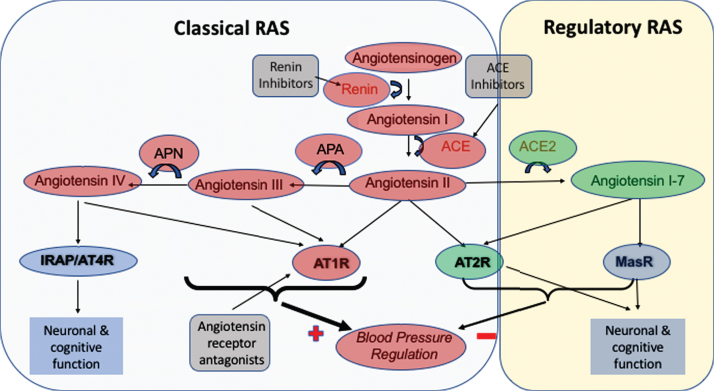Fig.2.
Summary of the RAS system, including the compartmentalization of RAS to illustrate components that are part of the ‘Classical’ RAS and the ‘Regulatory’ RAS. The Classical RAS revolves around the production of the vasoconstrictor angiotensin II by angiotensin I-converting enzyme (ACE), and possibly angiotensin III and angiotensin IV by the sequential actions of aminopeptidases-A and -N on angiotensin II and angiotensin III respectively, and resultant signaling through the angiotensin II type I receptor (AT1R). Signaling through AT1R is thought to be the main signaling process in RAS that increases blood pressure (denoted by the heaviest weight arrows). In contrast, stimulation of the angiotensin II type 2 receptor (AT2R), by angiotensin II serves to counteract effects of AT1R. The sites of action of currently licensed drugs, usually used for the treatment of hypertension are also indicated where Renin inhibitors and ACE inhibitors work to reduce the formation of angiotensin II, whereas angiotensin receptor antagonists serve to inhibit the binding of angiotensin II to AT1R and instead promote vasodilatory inducing stimulation of AT2R by angiotensin II. The ‘Regulatory RAS’ has a similar role to that of AT2R in working to reduce blood pressure, however this is achieved by the activity of angiotensin II converting enzyme 2 (ACE2) on angiotensin II to produce angiotensin1-7 that can also bind AT2R or bind its own Mas receptor (MasR) to reduce blood pressure as indicated by the arrows. Notable but perhaps less well-known functions of the RAS are the effects, as illustrated by various peptides binding to the Insulin Regulated Aminopeptidase receptor (IRAP) (or angiotensin II type IV receptor (AT4R)), AT1R and MasR respectively on neuronal signaling pathways that can contribute to learning and memory.

